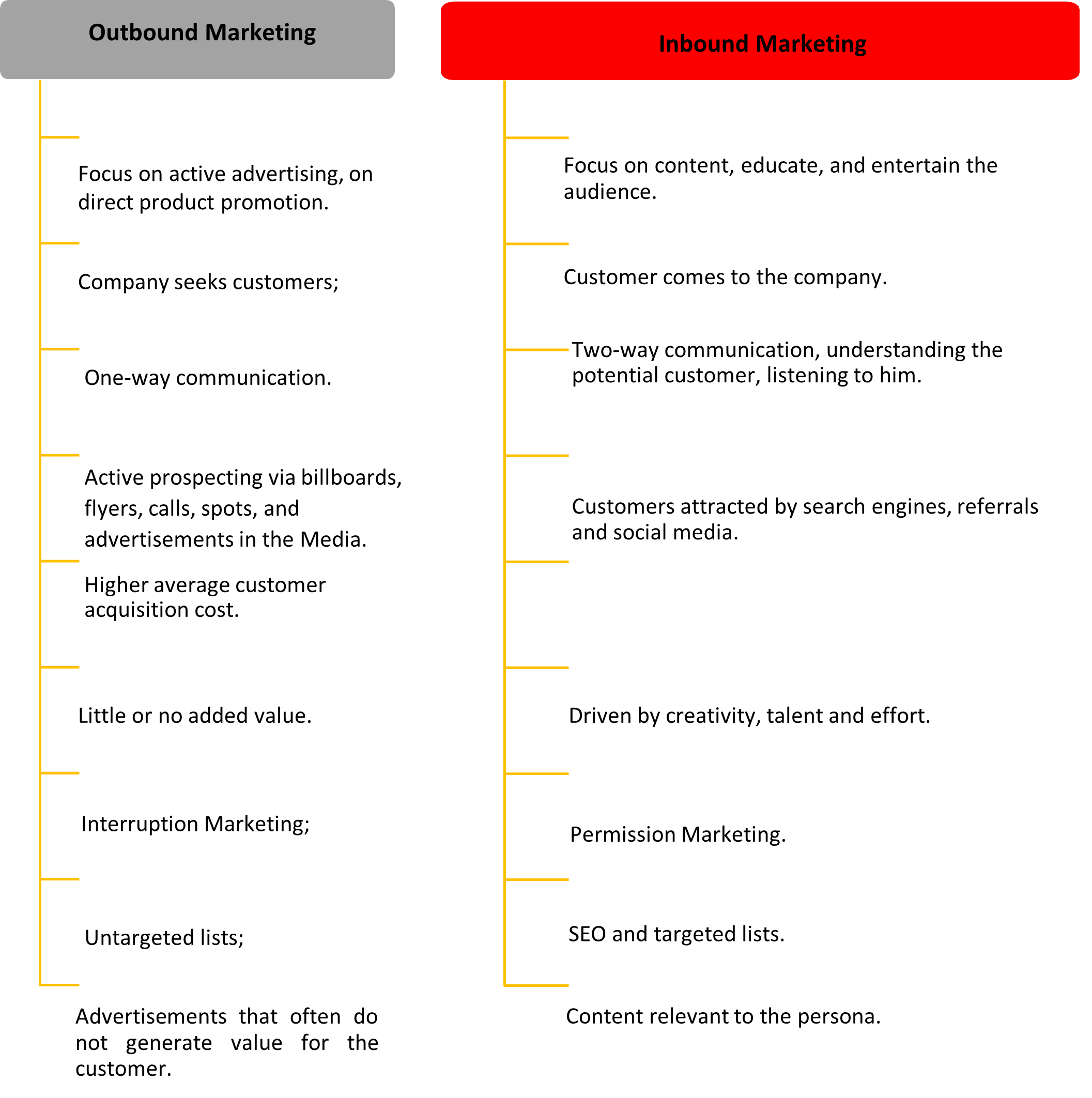Marketing has been changing and the main driver is the change in consumer buying behavior itself. In the past, marketing worked in masses, unlike today, which has followed a language more directed toward increasing the relationship between brand and customer (Philip Kotler, 2007).
In today’s article, we will talk about Inbound and Outbound Marketing strategies, explaining the differences between them.
Outbound Marketing
Traditional marketing, or called Outbound marketing, has as its main objective to bring customers offering services and/or products. In this case, the idea is to go after the customer and not necessarily originate the interest of that potential customer in the service and/or product. This type of marketing grew with the use of radio, television, newspapers, magazines, posters, and event sponsorship. In addition to these means, Outbound can also be present in digital marketing, such as banners, email marketing, and pop-ups (Patrutiu-Baltes, 2016).
Inbound Marketing
The rapid expansion of the internet has brought the need for individualized marketing to the forefront. Top marketers believe in a return to the marketing practices of more than a century ago, in which the warehouse owner was the personal purchasing agent, and the retailer was both a brand and a trusted companion, and the owner knew their customers fully, knowing tastes and customs (Patrutiu-Baltes, 2016; Aguiar & Bastos, 2016).
The main objective of Inbound Marketing is to attract and retain customers, that is, the main idea is not to go after the customer, but to arouse their interest so that they come to the company and be interested in what it can offer. Basically, it is being found by the public rather than being the company that finds you (Patrutiu-Baltes, 2016).
The attraction of potential customers is made by creating quality content, which is the main fuel for this type of marketing. Since the idea of attracting the public and arousing interest in the services and/or products you have to offer, it is necessary to understand who the target audience is, that is, it is necessary to know what their interests, questions, and challenges are, to then offer content that helps you solve the problems you have or makes you think of a good opportunity, where the solution is exactly the service and/or product that the company offers (Patrutiu-Baltes, 2016).
- Sales funnel
Sales Funnel (figure 1) is the name given to the Inbound marketing path, where the objective is to reach the bottom of the funnel to effectively originate new customers. The strategy aims to offer the target audience what they are looking for, avoiding the use of unsolicited and interruptive messages (Patrutiu-Baltes, 2016).

The first stage of the “Attract” funnel focuses on actions to attract visitors, where quality content is produced. Some of these steps involve creating personas, creating content based on the persona, planning publications, publishing content on the blog and social media, as well as applying SEO techniques to the content.
The next step “Convert” is focused on visitors who leave contact information in exchange for some benefit, ie, it is when visitors are converted to leads and enter the sales funnel. This step involves the production and planning of offers for each step of the funnel and the creation of landing pages.
Then comes “Engage”, focusing on transforming leads into customers, establishing relationships with them. It involves lead nurturing, email marketing creation, which will take us to the “Sales” stage that completes the sale of the service and/or product to potential customers, where the marketing alignment with the sales team enters.
Finally, the “Analyze” step is always important in order to verify the performance of the actions performed in Inbound marketing, by the defined goals, strategies carried out and results obtained. Since the ultimate goal may be to convert to sales and increase revenue, however, the focus is not on the product, but on the customer.
Outbound marketing vs. inbound marketing
It is very normal to adopt both methodologies in a company. What should be taken into account is the return on investment, as this will tell which channels are worth investing money and time in (Aguiar & Bastos, 2016).
Investment in Digital Marketing is easier to measure through clicks, conversions, and sales. What will facilitate the integration of Outbound and Inbound, is mainly your customer profile, the purchase journey, the company’s average ticket, the internal functioning of the marketing and sales team, and, finally, the management model of your organization (figure 2) (Patrutiu-Baltes, 2016).

Sources:
- Aguiar, K., & Bastos, F. (2016). INBOUND MARKETING FOR RETAIL: the key to attracting and retaining customers. POST IN MAGAZINE AT THE NEWTON PAIVA UNIVERSITY CENTER .
- Patrutiu-Baltes, L. (2016). Inbound Marketing – the most important digital. Bulletin of the Transilvania University of Braşov, p. Vol. 9 (58) No. 2.
- Philip Kotler, g. A. (2007). Marketing principles. Prentice Hall Brazil.